Olympus OM-D E-M5 Mark II Review
Olympus OM-D E-M5 Mark II Introduction
The Olympus OM-D E-M5 Mark II is the latest Olympus Mirrorless Digital Camera. It replaces the E-M5 which originally brought professional features to the Micro Four-Thirds format and was later superseded as flagship mirrorless digital camera by the OM-D E-M1 reviewed here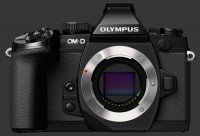
Olympus OM-D E-M1.
The new Mark II version retains the professional features of its predecessor, including a large built-in 0.5" EVF with Eye-Start Sensor and dual control-dials in a weather-sealed body. It adds a headline-grabbing 40 megapixels Super-Resolution mode which produces a high-resolution image by combining 8 separate exposure of its 16 megapixels CMOS sensor.
The 16 MP Four-Thirds sensor in the Olympus OM-D E-M5 Mark II offers a maximum ISO 25600 sensitivity and uses an anti-alias filter to avoid moire. It now boasts a new Low ISO 100 expanded sensitivity that is usable for Super-Resolution capture, along with sensitivities up to ISO 1600.
This camera introduces a faster shutter and new processing engine. Mechanical shutter-speeds up to 1/8000s and electronic ones up to 1/16000s are now possible. It can also capture full-resolution images at 10 FPS with a buffer for 19 JPEG images or 16 RAW files. Full 1080p HD video capture is also supported at 60 FPS.
Video features of the E-M5 Mark II are extremely sophisticated including Program, Aperture-Priority, Shutter-Priority and Manual exposure as well as Art Filters. Video focus modes include continuous autofocus (AF-C), subject-tracking autofocus and direct manual-focus (DMF). Stereo sound is recorded by a built-in microphone or an external one via a standard mini-jack.
This digital camera review covers the usability, performance and image quality of the Olympus O-MD E-M5 Mark II.
Olympus OM-D E-M5 Mark II Features
Sensor
- 16 Megapixels CMOS Four-Thirds sensor
- 5-Axis Sensor-Shift image stabilization
- Micro Four-Thirds lens mount
- Built-in ultra-sonic dust-reduction
Exposure
- Standard ISO 200 - 12800 sensitivities
- Expanded ISO 100 sensitivity
- Auto ISO, customizable ISO 200 - 25600 limit
- ISO Bracketing, 3 frames, maximum 1 EV steps
- 40 Megapixels Super-Resolution, ISO 100 - 1600, Electronic-Shutter 1/8000 - 8s
- PASM Exposure modes
- Program-Shift in P mode
- 1/8000 - 60s Mechanical Shutter-Speeds, 1/3, 1/2 or 1 EV steps
- 1/16000 - 60s Electronic Shutter-Speeds, 1/3, 1/2 or 1 EV steps
- Timed or Bulb Exposure, Maximum 30 mins
- EC, ±3, 1/3, 1/2 or 1 EV increments
- Exposure-Shift, ±1, 1/6 EV increments
- Multi-Segment, Center-Weighed, Spot, Shadow Spot and Highlight Spot metering
- Auto-Exposure Bracketing, 3, 5 or 7 frames, max 1 EV steps except 1/2 EV for 7 frames
- Flash Bracketing, 3 frames, maximum 1 EV increments
- FC, ±3, 1/3 or 1/2 EV increments
- Auto, Redeye, Forced, Off, Slow-Sync+Redeye, Slow-Sync, Rear-Sync and Manual flash modes
- Manual flash power between full and 1/64th power
- Remote-Control flash
Image Parameters
- AutomaticTwo types: Normal and Warm-preserving., 7 presetsSunny, Shade, Cloudy, Incandescent, Fluorescent, Underwater, Flash, Kelvin and custom white-balance
- White-balance fine-tuning along 2 axis in 15 steps
- Digital white-balance preview
- White-balance bracketing, 1 or 2 axis, 3 frames along each axis, 3 step sizes
- Optional One-Touch custom white-balance
- Optional Long-Shutter noise-reduction
- Optional High-ISO noise-reduction, 3 levels
- 14 Color and 2 B&W Picture Modes
- Adjustable contrast, sharpness, saturation, 5 steps each
- Adjustable gradation, automatic or 3 levels
- Adjustable tone curve, 15 steps for highlights and 15 steps of shadows
- sRGB or Adobe RGB color space
Focus
- Single-shot (AF-S), continuous (AF-C), direct manual-focus (DMF) or tracking autofocus
- Manual-focus (MF), optional display magnification up to 14X
- 35-area AF system, automatic or manual point-selection
- Face-Priority toggle
- Optional bulb focusing
- Optionally reset lens focus to infinity
- Controllable focus-ring direction
- Optional AF-Assist lamp
Drive
- 10 FPS Drive, 16 RAW files or 19 JPEG images
- Multiple-Exposure, 2 frames, optional automatic gain and composition overlay
- Time-Lapse, 1-999 Frames, 1s-24h59m59s Interval, 0-24h59m59s Delay
- Self-timers: 2s, 12s or Custom, 1-10 Frames, 1-30s Delay, ½s-3s Interval
- Shutter-Delay: 0, 1/8, 1/4, 1/2, 1, 2, 4, 8, 15. 30s
- Quiet Modes: Single, Continuous, Self-Timers
Video
- 1920x1080 @ 60 FPS
- 1280x720 @ 60 FPS
- Quicktime H.264 Codec
- 77 Mbps All-Intra Encoding
- Program, Aperture-Priority, Shutter-Priority and Manual video exposure
- Time-Lapse Video, 1280x720 @ 10 FPS
- Adjustable Audio-Volume, 21 levels
- Optional stereo sound with built-in microphone
- Optional external stereo microphone via mini-jack
- Optional Volume-Limiter
- Optional Wind-Filter, 3 levels
- Optional Art-Filters
- Built-in Time-Code
- Audio headset output via optional grip
Display & Viewfinder
- 0.5" EVF, 2.4 Megapixels
- 0.74X Magnification, 100% Coverage
- Built-in Eye-Start sensor
- Digital-level, 2-Axis
- Rotating 3" Touchscreen LCD, 1 Megapixel
- Optional HDR Preview
- Optional Live-Histogram
- Optional Framing-Guides, 5 types
- Optional Blinking-Highlights
- Optional Focus-Peaking
- Adjustable brightness, 15 steps
- Adjustable color, 15 steps, 1 axis
- Optional Touch-Screen controls
Controls
- Dual control-dials
- 5 Customizable buttons
- AE-L/AF-L hold and toggle modes
- Customizable AE-L metering mode
Output Processing
- 4:3 Native aspect ratio
- 3:2, 16:9, 1:1 and 3:4 cropped aspect ratios
- 12, 8, 5, 3, 2 and 1.2 megapixels modes
- JPEG, RAW, RAW+JPEG capture
- 4 JPEG Compression levels
- Optional Vignetting-Correction
Connectivity
- Standard Hot-Shoe
- Wired Remote port
- Built-in WiFi
- HDMI (1080p) output
- A/V (NTSC / PAL) output
- USB 2.0 connectivity
Misc
- Weather-sealed body
- Freezeproof to -10C
- Stabilization, 3 modesBi-Directional, Horizontal, Vertical
- SDXC memory
- Lithium-Ion battery
- Customizable battery warning
- Customizable DPI settings
- Copyright data
The Olympus OM-D E-M5 Mark II is extremely similar to the Olympus OM-D E-M5
Olympus OM-D E-M5 which was reviewed in-depth already. There are tweaks both inside and out which are detailed in this review. Those not familiar with the E-M5 should read its review to get the whole picture.
Olympus OM-D E-M5 Mark II Usability - How easy is it to use?
The Olympus OM-D E-M5 Mark II has a distinctively angular design with a large viewfinder hump hosting the EVF and hot-shoe. It also has a minimal hand grip which keeps it relatively slim. The camera feels solid in hand with a good weight. The only weak-point is the LCD hinge which shows some flex. Impressively, Olympus managed to make it weather-sealed.
The E-M5 Mark II can be securely held thanks to a prominent rubber protrusion at the back. There are eyelets on either side to attach a standard neck-strap. Too bad one digs uncomfortably into your index finger while reaching for the shutter-release though. Considering how light and relatively compact this mirrorless digital camera is, it can be used with a hand or wrist-strap instead.
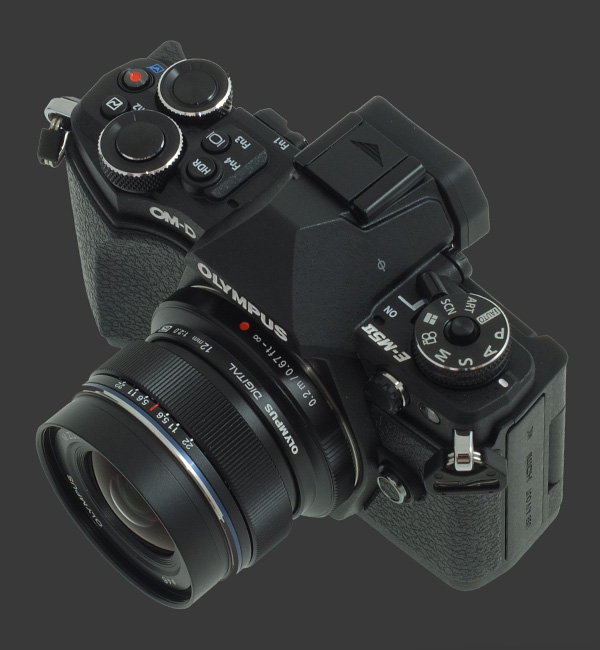
The top-plate of this camera is really busy. Starting near the right, there is a customizable Fn2 button which adjusts tone-curves by default. Adjustment are made with the front control-dial for highlights and rear one for shadows. Tone-Curves are adjustable in 15 steps each. The effect is easily visible on-screen for shadows but barely so for highlights. Fn2 can control EC instead which allows both modal and modeless exposure-compensation. Press and let go for the former or hold for the latter. Otherwise, the E-M5 Mark II forces assignment of EC to one of the control-dials which is accident-prone and is best avoided for beginners.
Below Fn2 is the Video-Record button which is thankfully customizable. It can be assigned so that the front control-dial sets ISO and the rear one sets WB. Since there is no direct ISO control on the E-M5 Mark II, this is the most sensible choice but a number of other options are available. Given that there is a dedicated Video mode, this button is otherwise redundant. While you could capture video in Stills mode that way, it makes no sense to do so since the preview usually shows the wrong aspect-ratio. Once in Video mode, the aspect-ratio is previewed correctly so that videos can be framed properly.
Just further in from the side are two control-dials with the shutter-release in the center of the front one. This is a standard two-stage release with moderate travel and a distinct halfway point. Full-press is just a hair lower. The position of the shutter-release would be more comfortable closer to the outer edge of the camera.
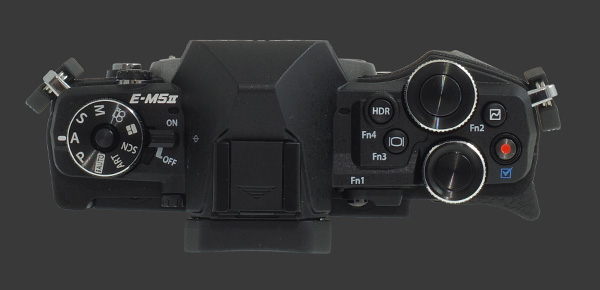
Both control-dials have nice detents. Control-dials can be configured independently for each mode, including Playback, and menus. In Manual mode, the only two choices are obviously Shutter and Aperture or vice-versa. In other modes, one of them controls the exposure-parameter, while the other must either be made redundant or adjust EC or FC. Customizing these dials comes down to personal choice but the OM-D E-M5 Mark II works best with one control-dial set to EC. This makes accidental exposure changes more frequent than ideal.
Two new buttons make their appearance on the top-plate. Those default to HDR and EVF/LCD Switching but also work as customizable Fn3 and Fn4 buttons. The HDR function is just a toggle. Actual parameters, such as whether the camera performs Exposure-Fusion or not, have to be chosen in the camera menu. The EVF/LCD Switch decides if the Eye-Start sensor shows a Status Display or standard Capture Preview on the LCD.
The viewfinder hump has a standard hot-shoe on top of it. The proprietary Accessory-Port of its predecessor is gone, favoring a standard mini-jack for audio input and Sync-Port for wired flashes. To its left, there is a typical Mode-Dial. The standard PASM modes are all present plus a fully automatic mode, called iAuto, along with Art Filter, Scene, Composite Image and Movie modes. The latter four modes each offer several sub-modes. In Movie mode, these sub-modes are PASM again.
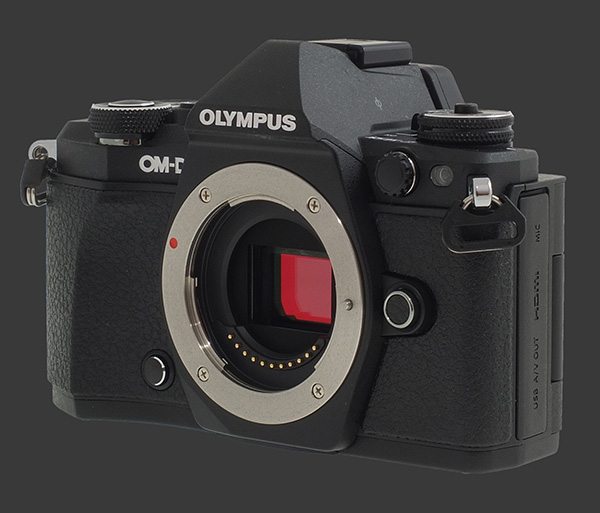
The front of the camera offers a single unmarked control which is customizable, located between the grip and base of the Micro Four-Thirds lens-mount. There are over 20 options to choose from. These same options can be assigned to any of Fn1, Fn2, Fn3, Fn4 or Video-Record, making the E-M5 Mark II extremely customizable.
All remaining controls are found on the back of the camera. The relatively compact size of the E-M5 Mark II limits space around the 3" LCD to little more than a small thumb-rest which makes it look rather busy. Since the LCD is hinged on the left, everything is squeezed to the right. Only Fn1 with its surrounding two-way switch is just above the right corner of the LCD. The two-way switch offers 6 different functions which toggle camera settings or even the behavior of several dials! Just remember what it is set to since this is as modal as it gets.
OM-D series cameras all feature a built-in EVF with Eye-Start Sensor. At 0.5" and 0.74X magnification with 100% coverage, the one on the E-M5 Mark II is is quite comfortable. It is extremely sharp with 2.4 megapixels, a fast refresh-rate and good contrast. Size and resolution are significantly upgraded compared to the original E-M5. The view is Exposure-Priority in M mode and updates according to EC. It is not Exposure-Priority in A or S mode though.
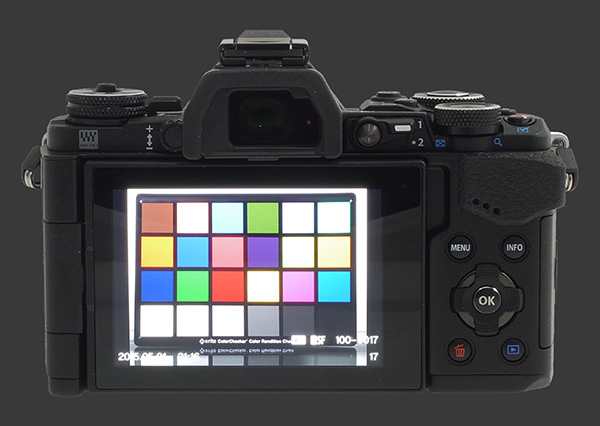
The Menu and Info buttons are located below the thumb rest. The former enters and exists the menu system and the latter cycles over display options on the LCD or EVF, whichever is active at the time. No surprises here, just the way it should be.
There is a 4-way controller with central OK button. By default, directions simply move the focus-point. The OK button invokes the Quick-Menu, the Super Control-Panel or both, depending on how the camera is configured. These are interactive ways to changing certain camera settings without using the menu system. The Super-Control Panel can set more options including WB Fine-Tuning and most Image Parameters. To operate it, the 4-way controller or rear control-dial selects an option and the front control-dial sets the amount.
Under the 4-way controller, there is a Delete and a Playback button. The Playback button behaves just as expected. The Delete button below the 4-way controller does nothing in Capture mode, even during instant review. To delete an image, one has to enter Playback mode.
The large rear 3" LCD has 1 megapixels and is sufficiently sharp to confirm focus without magnifying. Visibility is excellent and the anti-reflective coating does a fantastic job. Color temperature and brightness for the LCD can be set. Due to the limited contrast of the display, nuances in highlights are hard to see though.
This LCD now rotates which allows for shooting at odd angles but makes the camera more fragile and certainly more awkward to use for low and overhead shots. It is much more difficult to get the camera level when the LCD is extended out and away from the center of the lens.
The preview on the LCD is not Exposure-Priority, although it shows a good approximation in Manual exposure mode. In other modes, it shows the metered exposure offset by EC. The Live-Histogram is unfortunately based on display-brightness and is only reliable in M mode.
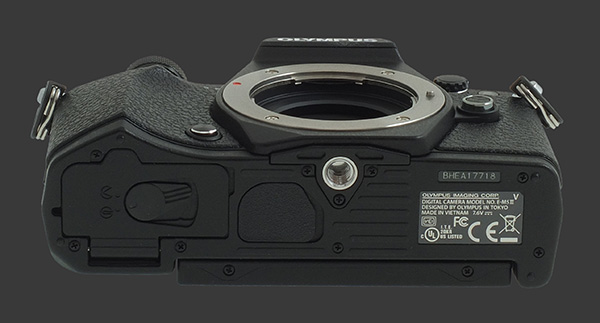
There are separate doors for memory and battery, making it easy to swap memory-cards while on a tripod. Both doors are quite sturdy. At the bottom of the E-M5 Mark II, there is a metal tripod socket, ideally for panoramic photography, is inline with the optical center of the lens.
This OM-D is extremely feature-rich and its complexity reaches a new level when considering how much it can be customized. Most photographers will eventually settle to a comfortable configuration which will become familiar after a while. It appears though that Olympus missed some opportunities to make this camera intuitive and easier to use. Making one control-dial set ISO outside of Manual mode would have greatly helped and removing the modal aspect of EC when assigned to one of the function buttons would have gone a long way.
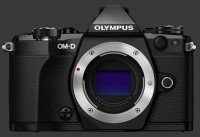 |
Please Support Neocamera
All information on Neocamera is provided free of charge yet running this website is a huge endeavor. Purchases made via affiliate links found throughout the site help keep it running and up-to-date. There is no additional cost to you, so please consider buying via these links to our affilates:
If you found any information on this site valuable and did not purchase via our affiliate links, please considering donating via PayPal:
Any amount will be greatly appreaciated. Thank you for your support!
Olympus E-M5 Mark II Highlights

Sensor-Size: 17 x 13mm

Actual size when viewed at 100 DPI
| 16 Megapixels Mirrorless | ISO 100-25600 |
| Micro Four-Thirds Mount 2X FLM | Shutter 1/16000-60s |
| 5-Axis Built-in Stabilization, 5-Stop Improvement | Full manual controls, including Manual Focus |
| 0.50" Built-in EVF 2.4 Megapixels (0.74X) | Custom white-balance with 2 axis fine-tuning |
| Automatic Eye-Start sensor | Spot-Metering |
| 2 Axis Digital Level | Hot-Shoe |
| Weatherproof down to -10C | Stereo audio input |
| Built-in Dust Reduction | Lithium-Ion Battery |
| 10 FPS Drive, 19 Images | Secure Digital Extended Capacity |
| 1920x1080 @ 60 FPS Video Recording | |
| 3" LCD 1 Megapixels |
Updates
2024.04.03

Fujifilm X-T5 Review
Newest Fujifilm flagship boasting a 40 MP APS-C sensor, 5-axis IBIS with 7-stop efficiency, 15 FPS continuous drive, 6.2K Video capture, dual control-dials and dual SDXC UHS-II slots in a sturdy weatherproof and freezeproof body.
2023.11.20

Best Digital Cameras of 2023
Find out which are the Best Digital Cameras of 2023. All the new Mirrorless Digital Cameras from entry-level to high-end professional.
2023.07.10

Fujifilm X-H2 Review
40 Megapixels APS-C Hybrid Mirrorless Digital Camera with 7-stop IBIS. Fastest shutter ever and 8K video capture. Large builtin EVF with 0.8X magnification and 5.8 MP, plus an Eye-Start Sensor. Packed with features and large number of controls in a weatherproof and freezeproof body.
2023.05.07

Sony FE 20-70mm F/4G Review
Review of the unique Sony FE 20-70mm F/4G lens. The optical zoom of this lens spans ultra-wide-angle and medium focal-length coverage, making it one of the most versatile Full-Frame lenses on the market.
2023.01.15

Huion Inspiroy Dial 2 Review
Review of the Huion Inspiroy Dial 2 tablet, a medium sized drawing surface with dual dials and customizable buttons. Connects via USB-C or Bluetooth 5.0 with Windows, Linux and Android support.
2022.12.08

How to Pack for a Photo Trip
Find out how to pack for a travel photography trip, carry your gear safely while meeting airline regulations.
2022.11.13

Best Digital Cameras of 2022
The best digital cameras of 2022. A short list of the most outstanding models in their respective categories. Choose one for yourself or as a gift.
2022.09.21

Pentax DA* 60-250mm F/4 SDM Review
Review of the Pentax DA* 60-250mm F/4 SDM, the constant-aperture telephoto zoom with the highest zoom-ratio on the market.
2022.09.20

Pentax DA* 50-135mm F/2.8 SDM Review
Review of the Pentax DA* 50-135mm F/2.8 SDM, the lightest professional telephoto zoom native to the K-mount.
2022.09.10

Pentax DA* 11-18mm F/2.8 DC AW Review
Review of the Pentax DA* 11-18mm F/2.8 DC AW, the widest professional ultra-wide zoom native to the K-mount.
2021.11.24

50 Gifts Under $50 For Photographers in 2021
50 Gifts photographers will love. All for under $50 USD. 2021 Edition.
2021.11.17

Best Digital Cameras for 2021
Neocamera shows which are the very best Digital Cameras for 2021 in every category: Mirrorless, DSLR, Premium Compact, Ultra-Zoom and Rugged.












